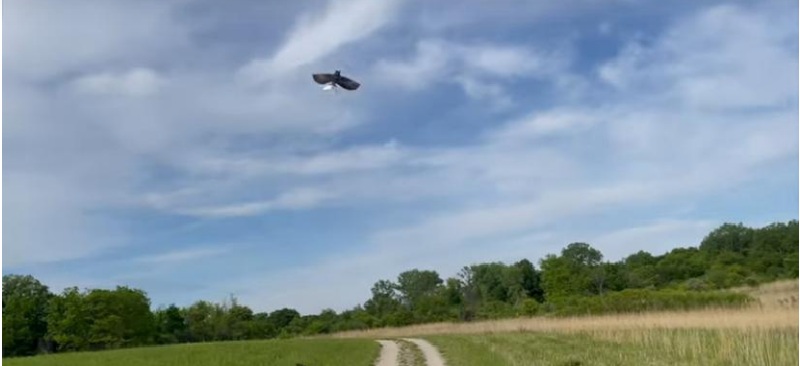By Jolly Masih, Pratik Modi & Harvinder Singh
The future of farming is no longer confined to the soil. It is soaring in the skies, led by a fleet of intelligent nano-drones that promise to make agriculture smarter, greener and more resilient.
Drones, or unmanned aerial vehicles, have transformed large-scale farming with high-resolution imagery and real-time data for monitoring crops.
They help detect pests, assess water stress and guide precise fertilizer and pesticide spraying. Some drones also support seed dissemination, reducing manual labor, optimising input use and improving overall farm productivity.
But they are often costly, bulky and difficult to operate for small farmers.
Nano-drones are smaller versions of conventional agricultural drones and offer a low-cost, high-efficiency alternative.
They can be used for micro-precision spraying, reducing pesticide usage, AI-powered crop health monitoring and early detection of plant diseases.
Their compact size allows them to access narrow and fragmented farm plots, making them ideal for smallholder farmers.
Equipped with advanced multispectral, thermal sensors and AI algorithms, nano-drones can capture high-resolution imagery, analyse plant stress and generate actionable insights in real time. This not only enhances productivity but also promotes environmentally sustainable farming by minimising chemical inputs and resource waste.
The latest research on nano-drones suggests several nations including India, US, Japan, Australia, Brazil, China and European countries such as Netherlands are adopting compact drones for crop monitoring, early pest detection and efficient resource management.
During the course of a multi-nation survey that one of the authors was a part of, a noted academic from the Netherlands observed that nano-drones can “enhance sustainability by reducing pesticide use and improving food quality”.
Research has shown nano-drone applications have helped optimise efficiency in farming. The Robotic Eagle-Micro Drone, for instance, shows the potential of bio-inspired nano-drones in tackling agricultural issues such as pollinator decline and crop monitoring.
Nano-copters or small helicopter-like drones can also be used to stimulate pollination and enhance productivity.
Unprecedented growth
The global agricultural nano-drone market is experiencing rapid growth.
Forecasts predict a 35 percent compound annual growth rate over the next decade. Governments and private investors are increasingly investing in this transformative technology, driving advancements in research, development and deployment.
Agrarian nations such as India, Brazil, and those in sub-Saharan Africa are actively adopting nano-drones. The small and nano-drones market is expected to reach USD 10.4 billion by 2030, growing at a compound annual growth rate of 8.6 percent from 2023, with a focus on agriculture and disaster management.
Policy recommendations are also advocating for subsidies and incentives that encourage small farmers to adopt drone technology.
Sustainability and climate resilience
One of the most compelling advantages of nano-drones is their ability to improve sustainability.
Traditional agricultural methods often lead to soil degradation and excessive water use. Smart agricultural technologies such as small and nano-drones optimise water use through precise irrigation, promoting sustainable agriculture in water-scarce regions.
Nano-drones ensure targeted interventions. By monitoring soil moisture levels with remarkable accuracy, these drones enable farmers to reduce water wastage significantly.
The seamless integration of nano-drones with sensor networks has proven effective in large-scale agricultural monitoring, improving crop yields while reducing reliance on chemical pesticides.
With the ability to detect plant diseases before visible symptoms appear, these drones prevent widespread crop losses, ensuring food security even in regions affected by unpredictable climatic shifts.
Newer varieties of nano-drones offer innovative solutions that enhance efficiency while reducing operational costs and environmental impact. For instance, nano drones such as AgroFly are designed for ultra-precise pesticide spraying, minimising chemical waste and ensuring that crops receive optimal protection without excessive exposure to harmful substances.
Another one called AgroWings is engineered for large-scale monitoring, equipped with AI-powered sensors that analyse soil health, detect nutrient deficiencies and provide real-time feedback to farmers.
Robotic Eagle uses advanced imaging technologies to identify early signs of disease, pest infestations and water stress, thereby allowing for timely interventions that prevent large-scale crop failures.
Climate change has led to increased instances of floods, droughts and pest infestations, all of which threaten global food security.
By leveraging real-time thermal imaging and multispectral analysis, it can detect early drought stress, assess flood damage, and track pest movements, enabling authorities and farmers to take swift, preventive actions before a crisis escalates.
AI-driven drones can track swarm movements, providing predictive analytics that enable authorities to deploy countermeasures efficiently.
These cutting-edge nano-drones are a departure from traditional, broad-spectrum farming techniques, enabling a shift towards an intelligent, data-driven approach that dynamically adapts to real-time field conditions.
By integrating AI, IoT and precision targeting, they empower farmers with actionable insights and autonomous capabilities, making agriculture more sustainable, resilient and productive in the face of modern challenges.
Autonomous agriculture
Nano-drones are expected to become even more advanced, integrating seamlessly with AI and IoT networks to create fully autonomous agricultural systems.
Future developments in this field include biodegradable nano-drones, which decompose naturally after use, thereby reducing electronic waste and promoting sustainability. Researchers are also working on self-sustaining drone swarms, capable of independent decision-making based on real-time environmental inputs.
With AI-driven analytics, future nano-drones will not only detect diseases and pests but also adjust their farming strategies dynamically, ensuring that crops receive optimal care without excessive human intervention.
This shift towards intelligent, self-regulating agricultural ecosystems will redefine food production, making it more efficient, sustainable and resilient in the face of global challenges.
Nano-drones offer a viable solution to some of the most pressing challenges faced by the agricultural sector today. The transition from large, unwieldy drones to intelligent (with onboard neural-network inference), compact nano-drones marks one of the most profound shifts in agritech history.
We need to seize this opportunity to make food production smarter and more sustainable — and not let it remain the privilege of large-scale farms.
Dr Jolly Masih is Associate Professor and scientist at BML Munjal University, Gurugram, India. Masih has received patents for nano drones Agrofly, Ecofly, Robofly and Robotic Eagle.
Dr Pratik Modi is Dean, School of Management, BML Munjal University. He is Professor of Rural Marketing and co-inventor, Robotic Eagle.
Dr Harvinder Singh is Professor, Leaders Institute, and Associate Professor, Torrens University, Australia. He is also co-inventor of Agrofly, Robofly and Robotic Eagle.
Ashish Sharma, EDO & Vice President, Strategic Data Products, Novartis, is also co-inventor of Agrofly.
Aard Groen, Professor, University of Groningen, Netherlands, also contributed technical content to this article.
Originally published under Creative Commons by 360info™.















